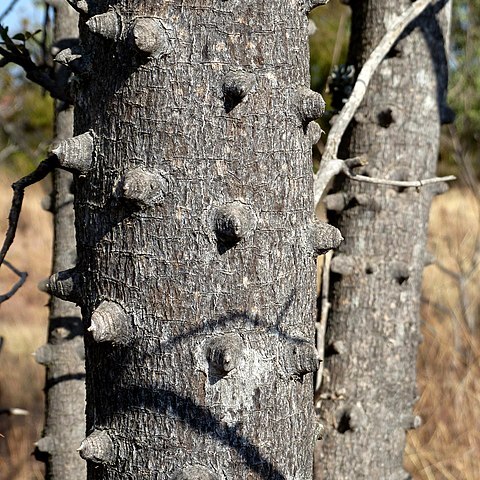Usually a small tree, 4-7(-10) m high, monoecious or dioecious, branches spinescent; stems and thick branches usually with knobs. Leaves alternate, imparipinnate; 4-8 pairs of leaflets plus a terminal leaflet, 10-40 x 10-20 mm, with 4-8 pairs of lateral veins, with immersed glands. Leaflets with margins crenulate or serrulate. Flowers unisexual, in terminal panicles. Calyx of 4, small, ciliate sepals. Petals 4, free. Male flowers: stamens 4, opposite sepals; ovary rudimentary. Female flowers: staminodes 4, inserted at base of stout gynophore 0.3 mm long; ovary glabrous, with immersed glands, obliquely obovate, unilocular, with 2 apical ovules; style simple, shorter than ovary and obliquely inserted; stigma capitate. Flowering time Oct.-Dec. Fruit a subglobose capsule, gland-dotted.
Tree or shrub, up to 13 m high; trunk and stems usually with spine-tipped corky knobs. Leaves pinnately compound, paripinnate, alternate; leaflets opposite, blade ovate to elliptic or obovate, 10-40 x 10-20 mm, apex usually obtuse or rounded, main vein may bear small sharp spines, 4-8 pairs of primary lateral nerves present, strongly lemon-scented when crushed. Flowers: in panicles; unisexual; calyx of 4 small, ciliate sepals; petals greenish yellow; Sep.-Mar. Fruit a globose, brownish red, prominently gland-dotted capsule. Seed shiny and black.
A shrub or small tree. It grows 13 m tall. The trunk and stems usually have spines. The leaves are compound with leaflets along the stalk. The leaflets are opposite and oval. They are 1-4 cm long by 1-2 cm wide. The leaves have a lemon scent when crushed. The flowers are greenish-yellow. The fruit are 4-4/5 mm across. The seeds are black and shiny.
Tree or shrub, up to 13 m high. Leaflets usually obtuse or rounded at apex, ovate to elliptic or obovate with 4-8 pairs of primary lateral nerves. Inflorescence bearing flowers of one sex only. Flowers greenish yellow.
Small, dioecious, prickly tree to 7 m. Leaves imparipinnate, leaflets obovate, lower smaller, toothed, with 4-8 pairs of veins. Flowers unisexual, in terminal or axillary panicles, whitish.


